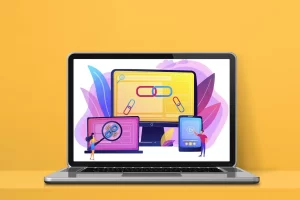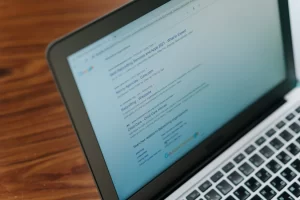Your blog may be full of fresh ideas, but without SEO, it might never reach its intended audience. Search engines don’t just reward originality—they reward optimisation. Imagine this:
- Website A has fresh, relevant content but lacks SEO.
- Website B has fresh, relevant and optimised content.
Which one ranks higher? The answer is obvious: Website B. If you want to boost visibility, drive traffic, and engage your audience, it’s time to optimise your content. Here’s how.
Key Takeaways
- SEO turns good content into discoverable content.
- Keyword research is the foundation of high-ranking blogs.
- Titles, links, and structure affect both user experience and SEO.
- Social sharing and subscriptions increase reach and loyalty.
- Track performance to keep improving content effectiveness.
Table of Contents
- Key Takeaways
- Start with Keyword Research
- Craft a Click-Worthy, Keyword-Rich Title
- Incorporate Internal Links Strategically
- Write for Readability
- Ensure Your Content is Unique
- Monitor Content Performance with Analytics
- Use Social Media to Expand Reach
- Add Blog Subscription Options
- Optimise Your Images for SEO
- Need Help? Partner with SEO Experts
- FAQ
Start with Keyword Research
Before typing a single word, know what your audience is searching for.
- Use tools like Google Keyword Planner or Ubersuggest.
- Target long-tail keywords with moderate search volume and low competition.
- Plan your content around terms your audience genuinely cares about.
Keyword research helps create content with intent—serving your readers and ranking on Google.
Craft a Click-Worthy, Keyword-Rich Title
Your blog title is the first impression on both search engines and readers.
- Include your primary keyword within the first 60 characters.
- Aim for clarity, curiosity, or value (“how-to,” “tips,” “reasons why”).
- Avoid clickbait—stay honest and relevant.
A compelling title increases click-through rates and signals relevance to search engines.
Incorporate Internal Links Strategically
Internal linking keeps users engaged and boosts site structure.
- Link to related blogs, services, or key landing pages.
- Use descriptive anchor text—avoid “click here.”
- Update older content to link to your newest posts.
This not only supports SEO but encourages users to explore more of your site.
Write for Readability
Clear, scannable content is easier for humans and algorithms to digest.
- Use short paragraphs (2–4 lines max).
- Include subheadings, bullet points, and numbered lists.
- Enhance with relevant images and white space.
If your blog is a pleasure to read, users stay longer—and Google notices.
Ensure Your Content is Unique
Original content builds authority and trust. Copied content damages SEO and credibility.
- Never copy from other websites—even your own.
- Use plagiarism checkers like Copyscape or Grammarly.
- Draw inspiration, but always offer a fresh perspective.
Unique content is more likely to earn backlinks and higher rankings.
Monitor Content Performance with Analytics
Track what’s working and refine what isn’t.
- Use Google Analytics to monitor bounce rate, session time, and conversions.
- Check Google Search Console for ranking keywords.
- Adjust content based on data-driven insights.
This helps you create more of what your audience loves.
Use Social Media to Expand Reach
Amplify your blog through the platforms your audience uses daily.
- Share new posts on Facebook, Instagram, LinkedIn, or X (Twitter).
- Join relevant groups or communities and offer value.
- Add social share buttons to each blog post.
Social signals may not directly impact rankings, but they boost visibility and engagement.
Add Blog Subscription Options
Turn one-time readers into regular followers.
- Add RSS or email subscription options.
- Encourage readers to opt in at the end of each post.
- Offer incentives (like free guides) for signing up.
Subscribers are more likely to return, share, and convert.
Optimise Your Images for SEO
Images enhance engagement—but only when properly optimised.
- Rename files with descriptive, keyword-based names (e.g., “seo-blog-strategy.jpg”).
- Add alt text that describes the image with relevant keywords.
- Compress images to reduce load time and boost speed.
Image optimisation improves accessibility and strengthens your SEO.
Need Help? Partner with SEO Experts
Optimising content can be overwhelming—but you don’t have to do it alone.
At TopRankings, we specialise in SEO copywriting that delivers results. From keyword research to content audits and optimisation, we’ll help you increase traffic and outrank competitors.
Contact us to elevate your blog and content marketing strategy.
FAQ: Optimising Blog Content for SEO
How often should I update my blog content?
Aim to review and update older content every 6–12 months to keep it accurate and competitive in search rankings.
How many internal links should I include?
Add 2–5 internal links per 1,000 words, depending on relevance. Prioritise value for the reader.
Can I use the same keywords in multiple blogs?
Yes, but target different aspects of the topic in each post to avoid keyword cannibalisation.
Does social media really impact SEO?
Social media can increase visibility and traffic. While it’s not a direct ranking factor, it helps indirectly through engagement and shares.
What’s the ideal blog post length for SEO?
Blog posts between 1,000–2,000 words typically perform best, but quality always outweighs quantity.



